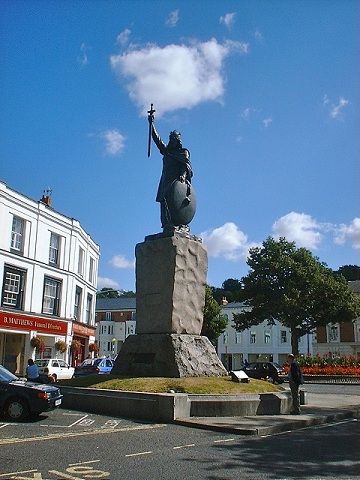By Tim Lambert
Alfred the Great was born in Wantage, Oxfordshire in 849. He was the youngest son of King Aethelwulf of Wessex. (In those days England was divided into four kingdoms, Northumbria in the north, East Anglia and Mercia in the Midlands, and Wessex in the south). In 868 Alfred married Ealhswith.
King Alfred is famous for fighting the Danes. In 870 the Danes invaded East Anglia. Soon they were in control of Northumbria, part of Mercia and East Anglia. They then turned their attention to Wessex. At the end of 870, they captured Reading. The men of Wessex won a victory at Ashdown. However, the Danes then won two battles, at Basing and an unidentified location.
Alfred and the Danes
Then in the spring of 871, Alfred became king of Wessex. He became known as Alfred the Great. The Saxons and the Danes fought several battles during 871 but the Danes were unable to break Saxon resistance so they made a peace treaty and the Danes turned their attention to the other parts of England. In 873 they attacked the unoccupied part of Mercia. The Mercian king fled and was replaced by a puppet ruler. Afterward, Wessex remained the only independent Saxon kingdom.
In 875 an army of Danes invaded Wessex again. However, they were unable to conquer Wessex so in 877 they withdrew to Gloucester. In 878 the Danes launched a surprise attack on Chippenham. King Alfred was forced to flee and hide in the marshes of Athelney. Alfred fought a guerrilla war for some months then took on the Danes in battle.
The Danes were routed at the battle of Edington. Afterward, Guthrum, the Danish leader, and his men were baptized and made a treaty with Alfred. They split southern and central England between them. Guthrum took London, East Anglia, and all the territory east of the old Roman road, Watling Street. Later this Danish kingdom became known as the Danelaw. Alfred took the land west of Watling Street and southern England.
However, in 886 Alfred’s men captured London. Moreover, the wars with the Danes were not over. In 892 some Danes who had been attacking France turned their attention to Kent. In 893 the Saxons defeated them and they withdrew into Essex (part of the Danelaw).
Meanwhile, in 893 another group of Danes sailed to Devon and laid siege to Exeter. They withdrew in 894. The Danes sailed to Sussex and landed near Chichester. This time the local Saxons marched out and utterly defeated them in battle. War with the Danes continued in 895-896. Danes from the Danelaw marched into what is now Shropshire but they were forced to withdraw. There then followed a few years of peace.

During his reign, Alfred reorganised the defense of his realm. He created a fleet of ships to fight the Danes at sea. (It was the first English navy). He also created a network of forts across his kingdom called burhs. Finally, Alfred died in 899. He was only 50. Alfred was succeeded by his son Edward.